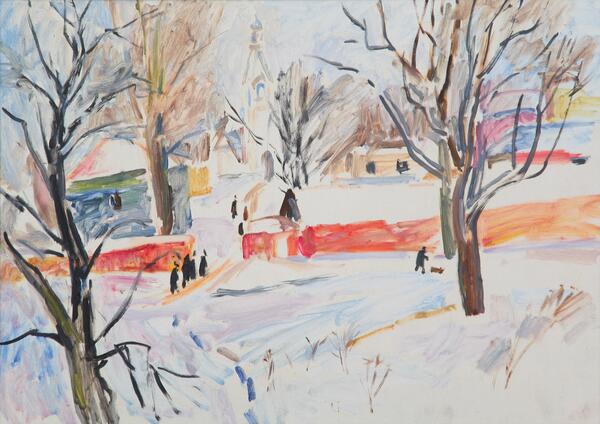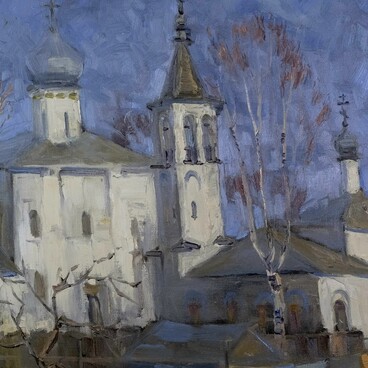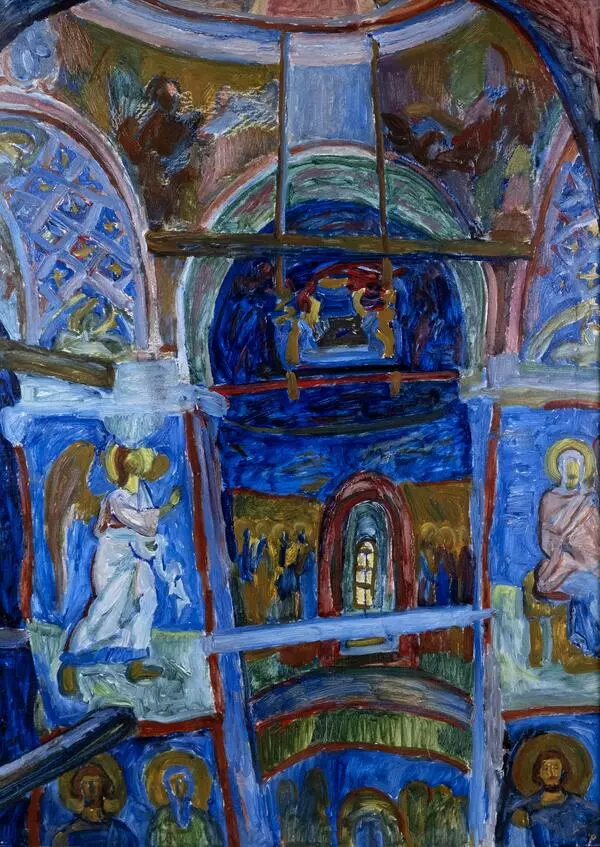Galina Georgievna Filippova moved to Novgorod from the village of Mama, Irkutsk Oblast, when she was six years old. From an early age, she was able to realize her artistic talent, largely thanks to teachers: Galina Yakovlevna Pustovoytova, Vladimir Stepanovich Ryabov, and later Eduard Nikolayevich Ivanov. In 1978, Galina Filippova graduated from the Vladimir Serov Leningrad Art School and became a certified restorer of oil paintings.
Subsequently, she restored wall paintings in the Antoniev, Klopsky, Valday Iversky, Yuriev and other monasteries. Presently, she teaches painting and composition at the Novgorod Children’s Art School. Since 1979, the artist has regularly participated in regional, interregional and republican exhibitions, as well as foreign ones — in Japan and Finland.
Galina Georgievna is a member of the Artists’ Union, one of the leading Novgorod artists, painter, and watercolorist. She works in pencil, pastels, crayons, and gouache.
The history of the Desyatinny Monastery, which is depicted in the painting, is full of mysteries. Its name may be a reference to “desyatina” — a type of tax or a plot of land imposed by it. It could also be derived from “desyatina” meaning a district in the diocese, which was ruled by a “bishop desyatinnik” (according to the 15th-century church charter). There was also a unit of measurement called “desyatina”.
The exact date of the foundation of the monastery is unknown.
In the Chronicle of Avraamka, the first bishop of Novgorod, the locally venerated Saint Joachim of Korsun, was named the founder of the monastery; he is also credited with building several churches in Novgorod.
According to another version, it was founded by the mother of St. Alexander Nevsky, Feodosia Mstislavovna. Indirect evidence of the monastery’s existence prior to the 14th century is the miraculous icon “Dorminion of the Holy Theotokos”. The icon belonged to the monastery, but, according to studies, was created in the early 13th century.
Historically reliable information about the monastery starts to appear in 1327. That year Archbishop Moses of Novgorod founded the Nativity Church. In the 15th century, the monastery housed monastic cells for archbishops. Hence, researchers conclude that the monastery was built at the expense of the Archbishop’s House of St. Sophia — the inherited property of the Novgorodian bishops, archbishops and metropolitans (since 1592), the former diocesan administrative center.
Subsequently, she restored wall paintings in the Antoniev, Klopsky, Valday Iversky, Yuriev and other monasteries. Presently, she teaches painting and composition at the Novgorod Children’s Art School. Since 1979, the artist has regularly participated in regional, interregional and republican exhibitions, as well as foreign ones — in Japan and Finland.
Galina Georgievna is a member of the Artists’ Union, one of the leading Novgorod artists, painter, and watercolorist. She works in pencil, pastels, crayons, and gouache.
The history of the Desyatinny Monastery, which is depicted in the painting, is full of mysteries. Its name may be a reference to “desyatina” — a type of tax or a plot of land imposed by it. It could also be derived from “desyatina” meaning a district in the diocese, which was ruled by a “bishop desyatinnik” (according to the 15th-century church charter). There was also a unit of measurement called “desyatina”.
The exact date of the foundation of the monastery is unknown.
In the Chronicle of Avraamka, the first bishop of Novgorod, the locally venerated Saint Joachim of Korsun, was named the founder of the monastery; he is also credited with building several churches in Novgorod.
According to another version, it was founded by the mother of St. Alexander Nevsky, Feodosia Mstislavovna. Indirect evidence of the monastery’s existence prior to the 14th century is the miraculous icon “Dorminion of the Holy Theotokos”. The icon belonged to the monastery, but, according to studies, was created in the early 13th century.
Historically reliable information about the monastery starts to appear in 1327. That year Archbishop Moses of Novgorod founded the Nativity Church. In the 15th century, the monastery housed monastic cells for archbishops. Hence, researchers conclude that the monastery was built at the expense of the Archbishop’s House of St. Sophia — the inherited property of the Novgorodian bishops, archbishops and metropolitans (since 1592), the former diocesan administrative center.





